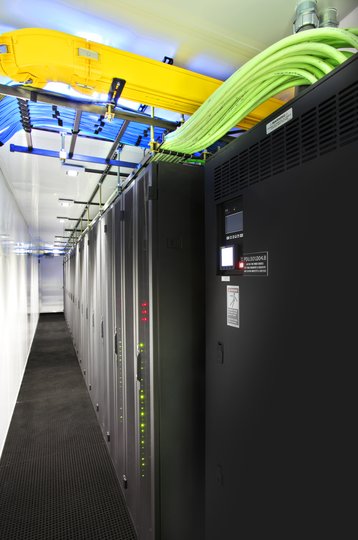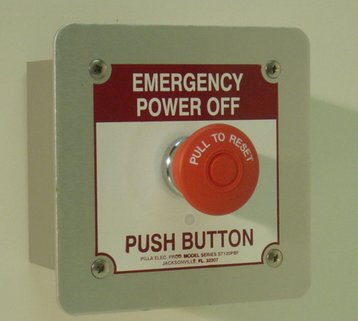Having spent the last fifteen months navigating the acronymic, windowless worlds of data centers, I have surfaced for some non-air-conditioned air and to collect my thoughts on the fieldwork experience. What follows is a sort of anthropological laundry list of some things I have learnt about the industry.
1. Data Center People, pl. n. Those who work, reside or dwell in data centers
Unlike many people imagine, data centers are not devoid of human beings, nor are the only people populating these places troglodytic computer technicians sitting in swivel seats in various states of anatomical atony. Data center demography includes snappily-dressed businesspeople, mechanical engineers, risk analysts and IT specialists all working together to deliver ‘scalable, agile and hyper-resilient IT resources and cloud services’, which probably means nothing to anyone outside of the data center industry.
2. Language
Data Center People have their own unique language: Data Center Speak. Mostly comprised of semanticless technical terms, Data Center Speak forms a kind of impenetrable ozone layer around the world of the data center industry. This jargon-heavy nomenclature strategically shields the industry from the prying interest of the general public, but it also inadvertently deters potential clients and people who may want to enter the industry. While not the most elegant-sounding language it contains some of the most beautiful and complex arrangements of acronyms you will ever hear.
3. Data Center People don’t socialise
They ‘connect’.
4. Real-time
New technologies continuously shift our experience of time. In the 19th century, the railway initiated a temporal shift from solar time to standard time and ‘seconds’ suddenly became important temporal indices. Cloud computing and Big Data have instigated another temporal shift to ‘real time’. Milliseconds, nanoseconds and attoseconds become increasingly important units of time, with real-time data seemingly providing us with ever-closer access to the now.
5. Data Centers are not human-friendly environments
They are cold, noisy and sterile. When standing in their aircon-swept aisles, it is clear that human comfort is not factored into the design of data centers: they are built with the sole purpose of providing optimal living conditions for data growth and survival.
6. Cities of Data
Data centers are often about 80 percent empty space. Sometimes a room is completely empty except in the middle, where server towers suddenly erupt out of the emptiness like skyscrapers full of data interminably flickering their light switches on and off. While server rooms look like miniature cities, our cities increasingly look like server rooms. Skyscrapers are being built that look like hard drives and smart homes are dissolving the distinctions between houses and hard drives. Soon human spaces will be measured in bytes which will open up a whole other Alice in Wonderland-type world of space where the external dimensions of spaces decrease while their internal storage capacities expand. As digital storage density continues to increase, it becomes ever-more difficult to comprehend or even relate to it with our pre-existing conceptualisations of spatiality.
7. A celestial machine
Earth has become a vast digital machine in which we are all now living. Cables girdle it and signals encircle it while sensors, scanners and screens fill it. Data centers are not just the engines of the digital economy, they are the whirring hearts of this planet-sized machine.
8. The Machine (Never) Stops
Data centers power hospital technologies, public transportation, streetlights, satnavs and thousands of services and devices that are mission critical to our daily lives. They power your Pokémon Go. The unseen lives of Data Center People begin and end trying to make sure the planet-machine never stops.
9. The omnipresence of disaster
Fear of digital disasters – technology failure, data loss, cyber-attacks, grid vulnerability - motivates a number of data center practices and discourses, from routine Disaster Recovery backup plans to the long-term bunkering of data in electromagnetic pulse-proof subterranean data centers. Consequently, data centers are being configured as infrastructures critical to not only supporting our data-based society, but also for backing-up and even potentially re-booting ‘digital civilization’, if it should collapse.
10. The digital future
Data Center People spend much of their time guarding, nurturing and protecting the data in their data centers. They are shepherds of the digital future and data is their flock, before it is farmed, cooked, visualised and analysed by corporations.
11. Data centers are important cultural artefacts
Data and the infrastructures that store it play an important part in the imagination of the digital future. As digital expansionism becomes ever more firmly based and irreversible, data centers can be seen as prisms through which we can explore the sociocultural tectonics of digital civilization.
12. The EPO Button is a career-changing button
13. Data center diet and habitat
Data centers are massive, power-hungry technosaurs constantly consuming vast quantities of energy. A very large data center may consume 30GWh of power in a year, costing its operator around £3,000,000 in electricity alone. Power is a data center’s food and connectivity is the fibre in that food. Their native habitat in the UK is outer-city industrial estate, where they can graze on a variety of telco connectivity without the security worries endemic to inner-city locations. However, their location varies dramatically across the globe, from abandoned nuclear bunkers to beneath Norwegian mountains where they feed peacefully on fjord-cooled water. Data centers can range from 200 to 1,000,000 square feet and are growing in size. A 1.3 million footer has apparently been spotted somewhere in Wales and, in Washington DC, a 100-acre data center was recently discovered.
14. Most Data Center People haven’t been born yet
The data center industry is dominated by middle-aged men. Despite being one of the most high-tech, youngest and fastest growing markets in the world, it suffers from a severe lack of young people. The industry would benefit from engaging more with the education sector and forging links with young people early on by encouraging them to think about where their smartphone, PlayStation, Facebook and Netflix services come from.
15. You can do an MA in Data Center Leadership and Management now
This course represents an important stepping stone towards addressing the issue mentioned in point 14 (above). There are also a number of professional, industry-recognised data center qualifications available from various training specialists.
16. Being truly good at data center management requires skills so specialised that many of them don’t have names
17. White Space
People from other racial and ethnic groups or cultures are very underrepresented within the British data center community. There are also barely any women anywhere. Maybe they have all been virtualised or maybe they were just never there in the first place. Whatever the reason, the industry in the UK is an island of white males.
18. Our bytes are getting bigger
In the data center industry, data storage is no longer discussed in terms of gigabytes and terabytes, but in petabytes, exabytes, zettabytes and yottabytes.
19. That memory of your 12th birthday party is taking up 2 gigs of space in you
The average human brain can hold around 2.5 petabytes of information. In a data center that would take up roughly 1,550 square feet.
20. Rockstars of data
Every year this global industry organises hundreds of conferences, expos, conventions and awards ceremonies where the rockstars of the data center world turn up to speak. Yet with its general lack of presence in the public sphere, the data center sector unfortunately remains something of an inward-looking industry. Consequently, these events are often like those islands you get in the middle of the ocean full of nothing but birds. Only the birds really know about them and only the birds really go.
21. The cloud without its clothes on
The little existing academic research on data centers typically argues that the industry strives for invisibility and uses the cloud metaphor to further obscure the political reality of data storage. My ethnographic experience, however, suggests that the industry is somewhat stuck behind the marketable but misleading cloud metaphor that really only serves to confuse potential clients. The industry is in fact busy trying to raise awareness that the cloud is a material infrastructure by rendering data centers more visible.
21.5.
We are thus finding a lot of media campaigns showing us ‘behind the scenes screens’ of the cloud. Most data centers now have an image gallery on their websites where you can scroll through various photographs of the building, or sometimes even manipulate a ‘3D virtual tour’ of their facilities. But visibility is not transparency.
Transparency isn’t simply a matter of making infrastructure more visible to the public, it’s about connecting the dots between data center imagery and the wider socio-political structures of knowledge and the vested interests that configure the conditions of visibility. As such, these images don’t really address the lack of public knowledge about the devastating environmental impact of human internet activity, or the ethics of extracting, distributing and storing peoples’ personal data in massive windowless warehouses they will never be able to access. What we are presently seeing is more a kind of tactical visibility, a sort of ode to the modern-day myth of ‘transparency’.
22. The ultimate goal of the cloud is uninterruptibility
Which sounds like Brave New World crossed with Infinite Jest.
23. You will never hear anybody say 100 percent uptime because the minute they say that, something goes wrong
Myths, beliefs and superstitions form an important part of data center lore, from stories of haunted servers to theories of electromagnetic pollution.
24. Data Centers are becoming Datacenters
This gradual fusion reflects the industry’s growing strength and cultural significance. It’s a kind of sociolinguistic acknowledgment that data centers are here and if they’re going to be here they need their own word.
25. Data center conferences are filled with astonishing facts and figures that serve to constantly confirm how exciting and uncharted the world of data is
These mind-boggling factoids are deployed to excite, thrill and shock by highlighting the breath-taking speed of technological development. Yet perhaps more astonishing than any of these statistics is the speed with which all these technological innovations become banal.
26. Data center photography is a thing
Data center photography is an emerging genre of photography primarily concerned with photographing the furniture of data centers in ways that make it look exhilarating. Photos of these technologically-endowed spaces saturate the industry, from decontextualised datacenterscapes to titillating glamour shots of pre-action mist systems and, of course, the occasional suggestive close-up of a CRAC unit.
27. Server lights
The image of an empty aisle flanked by futuristic-looking data server cabinets full of flashing lights has become what people imagine when they think of a data center. These little lights flicker as data from people doing things at that exact moment is sucked into or out of the facility through fiber-optic tentacles. They are fascinating, but also frightening in what they signify.
28. Compulsory connectivity
The cloud makes it incredibly easy for businesses to get online and access IT resources that once only larger companies could afford. The less-talked-about reverse of this is that the cloud also makes it incredibly difficult for businesses to not use the cloud. There is something uncomfortably normative about connectivity these days, an almost enforced conformity to be online. This also, of course, goes for people as well as businesses.
I would like to thank Datacenter Dynamics for inviting me to the EMEA Awards and DCD Converged in 2015 and 2016.



